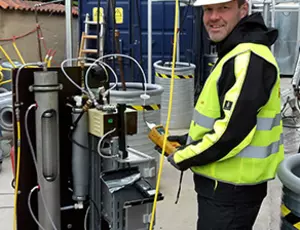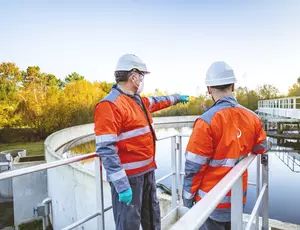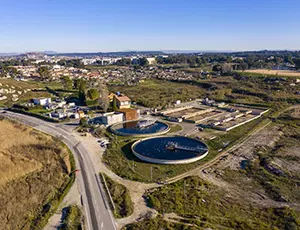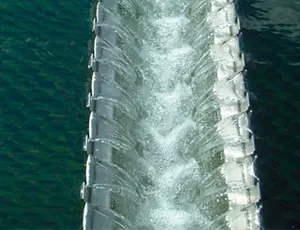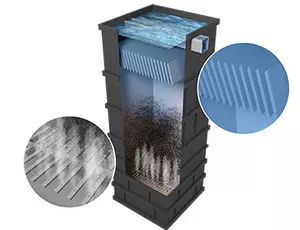Used in everything from pizza boxes and non-stick cookware to fire-fighting foams, per- and poly-fluoroalkyl substances (PFAS), also known as forever chemicals, are a large group of over 10,000 persistent, man-made chemicals that do not degrade and are very mobile in water.
BeyondPFAS is our global end-to-end offer for PFAS analysis and treatment. It means industries and communities alike can count on our expertise, from PFAS analysis to the treatment of contaminants.
Together, we can create a safer, cleaner and healthier future for all.
Micropollutants, particularly emerging contaminants such as PFAS, are understandably generating public concern.
PFAS comprise a vast family of more than 10,000 synthetic chemicals characterized by the ability to repel both water and oil and they are highly resilient against heat and chemical agents.
Their extremely resistant nature explains their wider adoption. However, this also means they build up in our environment indefinitely, known as bioaccumulation, causing severe pollution in our water sources and soil.
PFAS exposure is shown to have adverse effects on human health, including links to various cancers. As a result, regulations to both reduce the use of these chemicals and limit their spread are becoming commonplace.

BeyondPFAS provides our customers with a suite of end-to-end PFAS management solutions from sampling and analysis to responsible disposal of PFAS-contaminated residues in compliance with regulations.
It is underpinned by our global experience spanning over a century in environmental services and the management of complex pollutants.
BeyondPFAS is designed to offer our customers peace of mind when it comes to PFAS treatment owing to its ability to effectively address the challenges of contaminants and compliance with regulatory standards.
BeyondPFAS is a holistic offer that can be tailored to your needs whether you require filtration by spiral wound membranes, activated carbon, ion exchange resins or a combination of all three. Improve treatment operations via total organic carbon (TOC) monitoring for enhanced upstream precursor control and downstream cost savings.
Whether the application is drinking water, groundwater, industrial wastewater treatment or soil, we can meet your specific needs and local legislation with on-the-ground realities.
From initial contaminant detection to treatment and final disposal, our BeyondPFAS suite provides an end-to-end solution.
- Sampling and analysis: Precise detection and quantification of PFAS contaminants.
- Design and engineering: Tailored strategies for effective PFAS remediation.
- Operation: Implementation and management of PFAS treatment systems.
- Waste treatment: Responsible disposal and treatment of PFAS-contaminated residues.
Benefits of working with Veolia
- Largest technology portfolio
- Flexible project delivery models
- Innovative financing
- Customized waste management
- Comprehensive industrial and municipal experience
Adaptable solutions for PFAS treatment
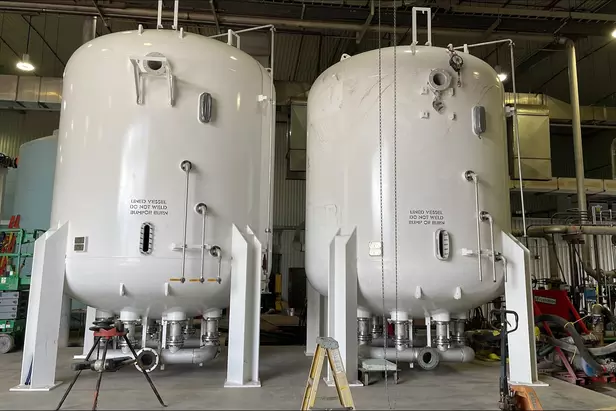
A customer faced multiple PFAS compounds in their process water, requiring treatment for reuse as boiler feedwater and safe disposal of the final residue. Our multi-technology solution combined filtration, two-pass membrane treatment, carbon adsorption and ion exchange polishing. This system achieved 80% water recovery, PFAS concentration in 20% of the original volume, and high-quality boiler feedwater. The solution saved the customer over $1 million annually in operating costs and reduced their water footprint by 80%.
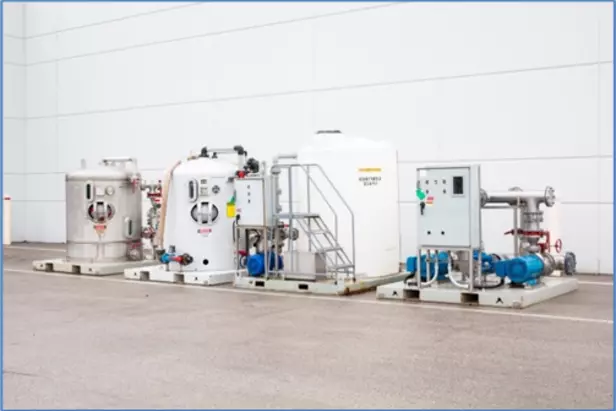
Our experts identified various PFAS compounds in the customer’s process water and were tasked with reducing the total concentration of these compounds from 2.9 micrograms per liter (µg/L) to 0.01 µg/L. They implemented specialty anion exchange resin using a pump and vessel arrangement with lead-lag operation. The soluiton met treatment specifications immediately with regular monitoring conducted weekly initially, then monthly. When a breakthrough occurs, the lead vessel is replaced with fresh resin, and the used resin is safely disposed of.
Discover our water treatment technologies for PFAS treatment
SEE ALL OUR TECHNOLOGIES
These complex synthetic substances have been found in the most remote areas of our planet and there is mounting concern regarding their impact. BeyondPFAS is scientifically proven, fully compliant with regulations and capable of securing a safer, cleaner future.

Philippe Sauvignet
Industrialization Manager - REUT expert
Contact Philippe through his LinkedIn account
Would you like more information about our technologies to support PFAS treatment solutions?
Resources
Find related content below. If you can’t find exactly what you are looking for please contact us for further assistance.
Brochure:
Technical paper:
Video:
FAQ
How can we treat PFAS?
Treating PFAS involves a multi-faceted approach due to their persistent nature, and each treatment needs to be tailored to specific site conditions and PFAS type. Common methods include activated carbon filtration, ion exchange resins and reverse osmosis for water treatment. Thermal desorption and soil washing are potential remediation strategies for contaminated soil. Ongoing research aims to develop more cost-effective and sustainable treatment solutions.
Do not hesitate to contact one of our experts to discover the best treatment for your PFAS challenge.
What are the primary sources of PFAS in the environment?
PFAS enters the environment through various industrial and consumer sources. Major contributors include:
- Manufacturing facilities that produce PFAS or use them in their processes, such as those making non-stick cookware, water-resistant textiles and firefighting foam.
- Consumer products like food packaging, cosmetics and cleaning products can also release PFAS during use and disposal.
- Waste disposal sites, including landfills, are sources as they collect and sometimes re-release PFAS-containing products.
- Agricultural applications of PFAS-contaminated biosolids as fertilizer have led to soil and groundwater contamination.
What is the bioaccumulation potential of PFAS?
PFAS have a high bioaccumulation potential due to their persistence and chemical properties. These compounds resist breakdown in the environment and living organisms, leading to accumulation over time. PFAS can concentrate in various tissues, particularly in protein-rich organs like the liver and blood. They also bind to proteins in the body, further enhancing their retention.
In aquatic ecosystems, PFAS accumulates in fish and other organisms, with concentrations increasing up the food chain. This biomagnification means top predators, including humans, can be exposed to higher levels through diet.
The long carbon-fluorine chains in many PFAS contribute to their lipophilic nature, allowing them to accumulate in fatty tissues. This bioaccumulation potential raises concerns about long-term exposure and potential health effects, even from low environmental concentrations.
What are the current regulatory standards for PFAS in drinking water?
Regulatory standards for PFAS in drinking water vary globally and are evolving as scientific understanding advances.
In April 2024, the Environmental Protection Agency (EPA) in the United States, established the following drinking water regulatory limits for PFAS and other synthetic chemicals:
- Four parts per trillion (ppt) for perfluorooctanoic acid — also known as PFOA — and PFOS.
- 10 ppt for perfluorononanoic acid (PFNA), perfluorohexane sulfonic acid (PFHxS) and hexafluoropropylene oxide dimer acid (HFPO-DA)
- A hazard Index of less than one for a mixture of two or more compounds: PFHxS, PFNA, HFPO-DA, and PFBS.
In Europe, the European Union has proposed a limit of 100 ng/L (equivalent to 100 ppt) for a sum of 20 PFAS compounds in drinking water. Some countries, like Denmark and Germany, have established their own limits.
These standards are subject to ongoing review and revision as new research emerges on PFAS health impacts and detection methods improve.
How can PFAS be detected and measured in water and soil?
PFAS detection in drinking water typically involves testing for 50-80 compounds using liquid chromatography-tandem mass spectrometry (LC-MS/MS). The Environmental Protection Agency (EPA) in the United States has established Methods 533 and 537.1 as standards, which employ techniques such as isotope dilution and solid phase extraction for the accurate measurement of PFAS concentrations.
PFAS detection and measurement in environmental and biological samples typically involve sophisticated analytical techniques.
High-resolution mass spectrometry techniques like QTOF-MS enable the identification of unknown PFAS compounds (non-targeted screening).
Ongoing research focuses on developing more cost-effective, field-deployable detection methods, including sensors and portable analytical devices, to facilitate widespread monitoring of PFAS contamination.




